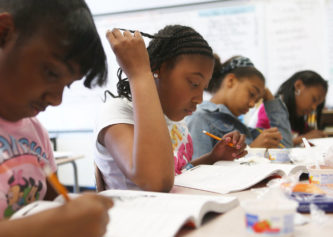
The researchers from the University of Texas at Dallas believe their approach could significantly close the achievement gap between middle-class and low-income students if applied on a much broader scale. This would have a major impact on the school performance of African-American students, many of whom come from low-income families in high-poverty neighborhoods.
The research team divided a group of 900 seventh and eighth graders into two groups—one group that received the training and one group that didn’t.
The training consisted of completing 10 different 45-minute sessions over a month, where they did group interactive exercises and written activities that taught them how to extract main ideas from text and analyze that information. The students were tested before and after the training to assess their improvement.
The researchers found that the cognitive training increased the reasoning and fact recall abilities in students from families in poverty as well as students from families living above poverty. The students who didn’t receive the training showed no improvement.
However, while there was improvement in seventh- and eighth-grade girls and eighth-grade boys, there was little change in seventh-grade boys. Researchers postulated that this was perhaps because those boys hadn’t yet reached a maturity level to benefit from the training.
“It’s really the cognitive steps you and I take quite naturally to understand information and get to the big picture. We walk [students] concretely through various stages,” Dr. Jacquelyn Gamino, who led the research team, told the Huffington Post. “We start by helping them focus on what’s most important by deleting what’s least important, we help them chunk information … get them to think at a higher level.”
After completing the cognitive training, Gamino said “kids in poverty showed as much improvement in them, even though they started out lower than kids not in poverty, which is good news.”
In the paper published in the journal “Frontiers in Human Neuroscience,” Gamino’s team explained that children’s “ability to make sense of and abstract meanings from information encountered through inferential processing is foundational to academic achievement. Unfortunately, recent studies indicate that many students in middle school focus primarily on learning circumscribed details presented in textbooks without showing an ability to understand issues at a conceptual, in-depth level. Whether the problem rests in the superficial coverage of vast amounts of information in class or how the students are learning, evidence is mounting that critical gist reasoning (i.e., the ability to derive synthesized meanings by combining facts and applying inferential reasoning) is failing to develop in early adolescence—an age where the brain is at a critical stage to acquire advanced reasoning skills.”
Researchers have found that the brains of students from poverty-stricken environments can develop differently than those of their more affluent peers, affecting the poorer children’s ability to problem-solve and pay attention. But Gamino thinks her work could turn that around.
“A lot of research is showing that kids raised in poverty—their brains are not developing at the same rate as kids not in poverty, potentially due to environment, stress level, etc.,” she said. “[Research showed that] kids in poverty who had deficits going in could overcome deficits.”
She said she believes the program they used could easily be integrated into a normal school setting in a way that would benefit all students regardless of socioeconomic background.
“I think we all know people who are very immature, who make bad decisions and don’t control their emotions. They haven’t developed the ability to use their frontal lobe to the full potential,” Gamino said. “The more we know from neuroscience, the more we know we can activate certain parts of our brain to make those connections become stronger. We have kids doing pen-and-paper tasks that help them use their frontal lobe.”


